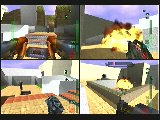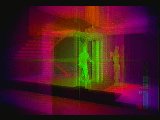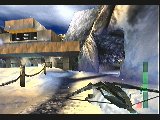


 Back To Reviews
Back To Reviews
Rating: Awesome
"It's even better than Goldeneye," said the hordes of preview-writers
and PR representatives. It seems like people say that about every first-
person shooter for any console these days, but in this case it's actually
true. Not only is it better than Goldeneye, but it's also better than
Quake 2 and every other first-person shooter ever made.
Like most first-person shooters, the heart and soul of Perfect Dark is
the multi-player game. Sure, the single-player game is well put together
with a decent story and unique mission objectives. Plus, the co-op mode
adds to the replay value of the game significantly, as does the innovative
Counter-Operative Mode. Despite all of this, though, it's the Combat
Simulator modes that really make Perfect Dark a classic.
Notice I said "Combat Simulator," not "multi-player modes." No matter
how many friends you have, there will still always be plenty of times where
you're all alone and you crave an intense, hardcore deathmatch. On these
occasions you can play a multi-player-style game by yourself with up to
eight computer-controlled players (or Simulants).
The Simulants range in difficulty from the almost helpless MeatSim to
the almost invincible PerfectSim. Unlike the computer-controlled players
in many other first-person shooters, Perfect Dark's Simulants actually
behave a lot like real humans rather than robots. Even the EasySims are
far from easy when you're first starting out with the game. Each increase
in difficulty level causes the Simulants to get significantly smarter,
rather than just having their accuracy stats boosted like the sims in
Turok: Rage Wars.
In addition to changing the difficulty level of the Simulants, you can
also make them a specific kind of Sim. Besides the obvious things like
TurtleSims that are very slow but have high armor, there are also
innovative things like VengeSims, which go out of their way to hunt down
the last player who killed them. It's also fun to play with PreySims,
which go out of their way to hunt down the player or players who have the
lowest health or fewest weapons (and the JudgeSims, whose sole purpose in
life is to kill PreySims).
Perfect Dark's graphics won't amaze you like a Dreamcast or PS2 game,
but they're still impressive in their own right. There is a surprisingly
large amount of blood present for a game published by Nintendo, and the
squeamish can still turn off the blood completely in the options menu.
The game looks better if you have an N64 Expansion Pak, which you'll
need anyway unless you don't mind missing out on the three-player, four-
player, and main single-player games. If you play the game with the
Expansion Pak, you have the option of turning on Hi-Res Mode, but it's
actually better to leave this mode off. The Hi-Res Mode doesn't really
make the game look better at all, but it does lower the frame rate
considerably.
You can tell when the frame rate drops in three or four-player games
with lots of Simulants because there is some noticeable slowdown. However,
this doesn't happen very often and even when it does happen, it's very
minor and it's equally distributed across all players. The frame rate goes
down intentionally when you're punched with an annoying motion-blur effect
that can prevent you from seeing much of anything at all if you're punched
repeatedly.
Perfect Dark's sound gives me the impression that Rare correctly
identified the flaws in Goldeneye's sound and worked hard to fix them.
Goldeneye's music could be more than a little annoying at times, while
Perfect Dark's music is actually quite catchy. Whether you're listening to
one of the game's better music tracks or not, the music is always much less
obtrusive than it was in Goldeneye, making it much easier to tune out if
you want to.
Goldeneye's weapon sound effects were mostly generic with only a few
exceptions, while Perfect Dark's sound effects actually make the game more
entertaining. For example, when you hear the high-pitched sound of a
rocket being fired from a Slayer, you might not know who fired it or where
they are, but you do know that you better run like hell or fight back
quickly if you want to survive. The same goes for the distinctive sounds
of the FarSight, Reaper, and so on.
The amount of options at your disposal in the multi-player game alone is
mind-boggling. There are lots of pre-set scenarios with different groups
of weapons in them, but you can also have the game randomly select the
weapons, or customize a pre-set group to your liking, or put it on random
and then customize what comes up, and the list goes on and on. Not only
can you decide which weapons show up in any game, but you can even rank
their availability from one to six, with one being the most common and six
being the least common.
You can also change the body and head of your character and the computer
players, choosing from a seemingly endless list of heads and bodies. All
of these can be mixed and matched, so you can play with my friend Andy
Reiner's head on a woman's body, or any other combination you can think of.
The only thing you can't do is put your own head into the game through the
use of the Game Boy Camera (this feature was taken out of the game for
political reasons).
I can't be held accountable for my actions if I hear one more person who
doesn't own an N64 say that Perfect Dark can't be that good because it
doesn't have the PC's almighty mouse-and-keyboard set-up. You can
customize Perfect Dark's control set-up any way you want on the N64's
controller, but the default setting is just about flawless.
You can quickly activate each weapon's secondary function by holding down
the B button. Also, you can now switch to a particular weapon quickly and
effortlessly (even if you have six of them) by simply holding the A button
to bring up a little menu. Other than these two changes, the default
control set-up is identical to Goldeneye's, which is just fine with me.
I have spent a lot of time using both this button lay-out and the PC's
mouse-and-keyboard lay-out, and I think they're both about equally
effective and intuitive. The much-heralded "mouselook" feature of the PC
(which lets you look around using the mouse) is easily duplicated by the
N64's analog joystick.
Also, when compared to any first-person shooter on the PC, winning and
losing in Perfect Dark has a lot more to do with skill and a lot less to do
with the speed of your Internet connection. Don't get me wrong, I'm not
saying that there's no skill involved in doing well in a PC first-person
shooter, but the lag factor is always there to give some players an
advantage and other players a disadvantage. In a console shooter, lag
isn't a factor and players win or lose based solely on their own skill.
Many people complain that the Quake games are based too much on running
around finding items, and that it would be better if everyone had the same
weapons at all times. I don't agree with this method of thinking as it
relates to the weapons, do I find that Perfect Dark is more skill-based as
a result of its lack of health power-ups. With no health power-ups to be
found, how long you can survive in the game is actually dependent on how
much damage you have taken, not how many health power-ups you have managed
to stumble across.
It's important for any multi-player first-person shooter to have good
level design, and Perfect Dark comes through in this area. While there are
certainly some arenas that you won't enjoy as much as others, none of the
arenas just plain suck, and most of them are excellent. The arenas have
multiple elevations while still not having any safe sniping spots, and
they're also spread out nicely while still having rooms that always seem to
be crowded. Three arenas from Goldeneye (Complex, Temple, and Facility)
are also playable in Perfect Dark, and they have been slightly re-designed
to increase their playability even further.
Perfect Dark's biggest problem from a balance standpoint is that the
weapons with splash damage (essentially the rocket launchers and grenade
launchers) are just a little bit too effective. The problem lies in the
fact that even if you don't actually connect with your target, the
explosion from the rocket or grenade still has a good chance of killing
it. Even if you're one of those people who think weapons that can kill you
with one shot are cheap, the fact of the matter is that you have to aim at
your target with precision accuracy and connect with them. With Perfect
Dark's splash damage weapons, you just have to connect with the general
area around your target.
The splash damage weapons can be particularly frustrating when you're
playing with Simulants. At the first few difficulty levels, the Simulants
aren't very good at hitting you with their weapons dead-on, but they don't
fire wildly and shoot their weapons so that they don't come anywhere near
you. So, they don't hit you directly, but they come close to hitting you
directly, and that's all you have to do in order to kill someone with any
of the splash damage weapons. Despite all of this griping about the splash
damage weapons, they are still balanced somewhat by the fact that it's very
easy to accidentally kill yourself with one of them, and the Simulants
accidentally kill themselves fairly often.
Other than the splash damage issues, Perfect Dark is almost flawlessly
balanced in every possible way. The last several months of Perfect Dark's
development were spent balancing the game to perfection. This hard work and
patience paid off, making Perfect Dark one of the few games from Nintendo
and Rare that's actually worth the wait. Perfect Dark has a huge variety of
weapons and almost every single one of them can be devastating if used to
its fullest potential. Herein lies the beauty of the game: Almost every
weapon has something about it that makes you think it's one of the coolest
weapons you've ever seen, but it also has something about it that prevents
it from being too powerful for the sake of the game's balance.
Take the FarSight, for example. The FarSight in its simplest form is
basically a rail gun, and it also has an extremely cool Target Locator that
goes through walls to scan the level for enemies, which you can then fire
at by pressing the Z button. To balance things out, the scanning cursor
moves very slowly, making it easy to kill a stationary target but hard to
kill a moving one. And of course, the whole time you're using the Target
Locator (which is pictured in the middle screen shot below), your character
is standing in one place on the level, completely defenseless to any attack.
If you don't already own a Nintendo 64, it will be worth every penny to
buy one along with Perfect Dark and an Expansion Pak. Not only does this
game not get old as you play it more, but I actually seem to develop a
greater appreciation for it with each passing hour, day, and week. I have
no doubt that I'll still be playing Perfect Dark months and possibly even
years from now.
Send your thoughts on this review to ivan@mastergamer.com



 Back To Reviews
Back To Reviews

© 2001 ivan@mastergamer.com